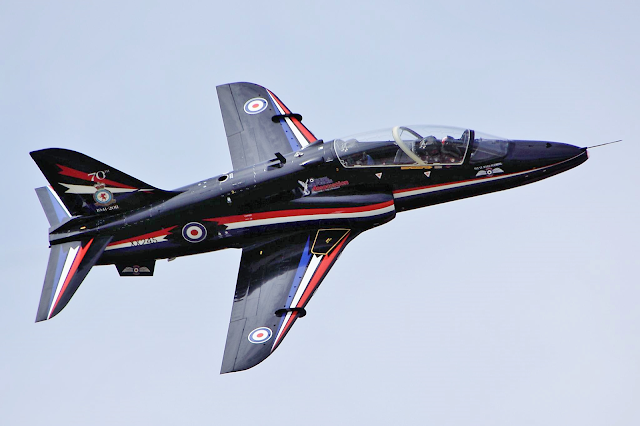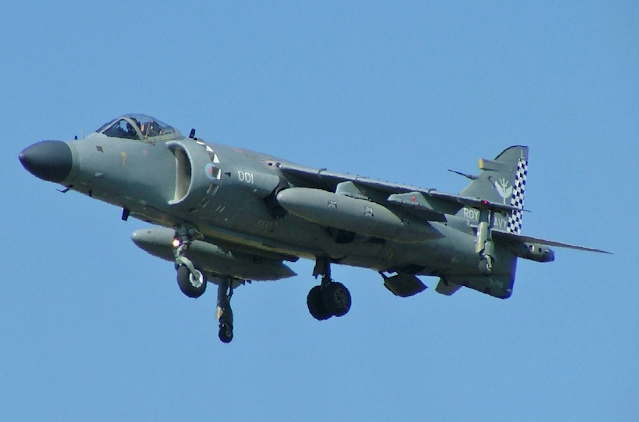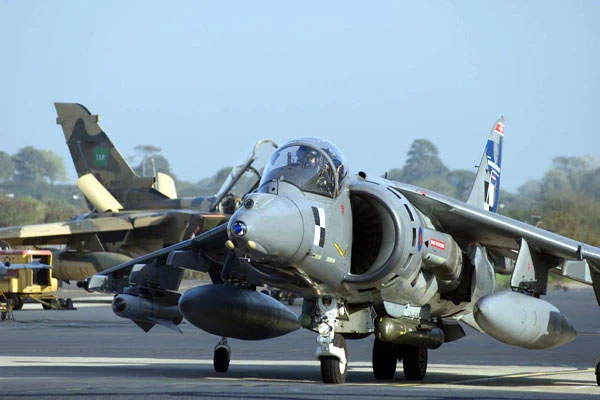From Sopwith Camels to Spitfires to the cutting-edge supersonic jets of today, spanning dogfights over Flanders, the Battle of Britain, and beyond, the Royal Air Force (RAF) has consistently soared to the rescue in Britain's moments of dire need.
As one of the oldest and most renowned air forces worldwide, the RAF's history reflects the narrative of the United Kingdom itself over the past century and beyond.
During the First World War, history witnessed the inaugural aerial combat, with British biplane fighter pilots leading the charge in the battle for supremacy among the clouds.
Amidst the harrowing Blitz and Hitler's Luftwaffe, the RAF emerged triumphant during the Battle of Britain, safeguarding the United Kingdom, the Allies, and the world from the clutches of Nazi conquest.
The post-Second World War era posed significant challenges, including economic decline, the dissolution of the British Empire, and the trauma of the Falklands War. Nevertheless, Britain, fortified by its rich traditions, time and again reinvented itself, rising stronger than ever. Presently, the nation stands as a stalwart member of the North Atlantic Treaty Organization (NATO), sharing a Special Relationship with the United States, and ranking among the most vibrant and influential countries on the planet.
Symbolic of this resilience, the RAF and Royal Navy personify the spirit of the nation. Now, let us delve into the world of fighter jets, which have been and continue to be a source of immense pride for the British armed forces.
10. Eurofighter Typhoon
 |
| Eurofighter Typhoon |
As previously alluded to, the RAF has seen several primary fighter jets in its illustrious history, ranging from the legendary Sopwith Camels and Spitfires to the forthcoming coverage of the Harrier jets. Today, the Typhoons stand as the RAF's primary fighter jets.
Introduced by the RAF in 2003, the Typhoon represents a twin-jet fighter aircraft also utilized by the German, Italian, and Spanish Air Forces. With its multirole capabilities, this fighter can engage in dogfights and ground operations, with a primary emphasis on air superiority.
In 2011, the Typhoon marked its combat debut, carrying out ground strikes during the United Kingdom's involvement in the Libyan Civil War. However, due to its limited ground engagement capabilities, the Typhoon's participation in anti-ISIS strikes remained restricted, leading to the delayed retirement of the Tornados, as described below.
9. Panavia Tornado
 |
| Panavia Tornado |
First manufactured in 1974, these fighter jets were deployed by the Royal Air Force as part of the Coalition forces' efforts against Saddam Hussein during the Gulf War in 1991.
Similar to the Typhoon, the Tornado jets were also produced for Italy and Germany, with the latter employing them for NATO operations in the late 1990s during the Yugoslav Wars.
Originally scheduled for retirement in the 2010s, these plans were postponed due to the emergence of the Islamic State of Iraq and Syria (ISIS). From 2014 to 2018, the RAF employed the Tornados to strike ISIS targets on multiple occasions.
In 2018, nine Tornados performed a flyby over London to commemorate the Royal Air Force's centenary, and these venerable fighter jets were finally retired in April 2019.
8. Lockheed Martin's F-35B Lightning II
 |
| Lockheed Martin's F-35B Lightning II |
A testament to the Special Relationship between the United Kingdom and the United States, the F-35B Lightning II represents the close military alliance shared by both countries. This variant of Lockheed Martin's F-35 was originally developed for the United States Air Force.
The Lightnings, as they are referred to within the RAF, succeeded the Tornados and the British Aerospace Harrier II. Single-engine and single-seat, these fighters are designed to excel in stealth capabilities, air superiority, and air-to-ground combat.
Moreover, these fighter jets possess the unique ability to take off and land on aircraft carriers, with the Lightnings achieving this feat for the first time as RAF aircraft in October 2019 aboard the HMS Queen Elizabeth.
These characteristics collectively render the F-35 one of the most versatile aircraft in operation today.
7. British Aerospace Hawk
 |
| British Aerospace Hawk |
Comprising two variants, the T1 and T2, this jet continues to serve and remains one of the RAF's most advanced trainer fighter jets. While not primarily employed in combat, simulated combat missions are integral to their training regimen. Additionally, the Red Arrows, the RAF's renowned aerobatic team, exclusively rely on these aircraft.
These planes have enjoyed a long lifespan, and with the Ministry of Defense setting a target retirement date for the T1 by 2030, they are expected to remain in service for several more years.
6. Folland Gnat
 |
| Folland Gnat |
The British Aerospace Hawk T1s and T2s replaced the Folland Gnats when they first entered service. Introduced in 1962, the Gnats were retired by the Royal Air Force in 1979 following the procurement of sufficient Aerospace Hawks.
Although they were never employed as combat jets by the Royal Air Force, they played a significant role as trainer aircraft. However, the Indian Air Force utilized them in combat situations, deploying them in two wars against Pakistan.
During the Indo-Pakistan Wars of 1965 and 1971, the Gnats triumphed over Pakistan's Canadair Sabres, another aircraft with ties to the RAF. Their victories significantly contributed to the Indian Air Force's overall efforts.
5. Harrier Jump Jet
 |
| RAF Harrier Jump Jet |
For decades, the Harrier family of jets held a prominent position within the Royal Air Force, with its lineage tracing back to the initial offering by British manufacturer Hawker Siddeley, which ceased operations in 1977.
Since its introduction in 1969, the Harrier jets have served generations of aspiring pilots. While their handling characteristics may appear challenging by contemporary standards, they were specifically designed for convenience, enabling operations in locations away from traditional airbases and facilitating aircraft carrier landings.
Besides the RAF, the United States Marine Corps and the Indian Air Force also procured Harrier Jump Jets. Presently, these aircraft have been retired from military use by all parties.
4. British Aerospace Sea Harrier
 |
| RAF British Aerospace Sea Harrier |
The Sea Harriers, successors to the initial wave of Harrier jets, were primarily operated by the Royal Navy, allowing for takeoff and landing capabilities on aircraft carriers.
During the Falklands War, they actively participated in combat. Launched from the HMS Hermes and the HMS Invincible, Sea Harriers proved highly effective against Argentine aircraft, downing numerous opponents without suffering any air combat losses.
Subsequently, HMS Invincible deployed Sea Harriers for combat operations during NATO's involvement in the Yugoslav Wars. Additionally, the Indian Navy acquired these aircraft. The Royal Navy retired the Sea Harriers in 2006, followed by the Indian Navy a decade later.
3. British Aerospace Harrier II
 |
| British Aerospace Harrier II |
Introduced in 1985, the Harrier II was utilized by the RAF and, for a brief period, the Royal Navy. Its primary purpose was tactical strikes and close aerial support missions.
The development of the aircraft involved collaboration with US manufacturer McDonnell Douglas. Following the closure of Hawker Siddeley in 1977, British Aerospace assumed responsibility for the project's continuation.
Although the Harrier II conducted patrols in no-fly zones, it did not engage in combat. However, it saw action during NATO's involvement in the Yugoslav Wars, contributing to precision-guided strikes in Bosnia.
The Indian Air Force employed the Harrier II as part of a peacekeeping force. During the Kargil War in 1999, it participated in combat operations against Pakistan, carrying out laser-guided bomb drops.
2. SEPECAT Jaguar
 |
| SEPECAT Jaguar |
The SEPECAT Jaguar, introduced in 1973, found service in the Royal Air Force as well as the French, Omani, and Indian Air Forces, with the latter still utilizing the aircraft.
French and British forces employed the Jaguar during the Gulf War as part of the Coalition. Subsequently, these forces again utilized the aircraft during the Yugoslav Wars as part of NATO operations, conducting numerous missions.
The British squadron responsible for the Bosnian strikes in 1995 became the first British planes to engage in a bombing run in Europe since the conclusion of the Second World War.
1. Tempest
 |
| RAF's future Tempest project |
Miranda's famous line from The Tempest, "Brave new world that has such people in it!" holds particular relevance here. Drawing inspiration from Shakespeare's play and the tempestuous weather often experienced in the British Isles, the RAF's future is symbolized by the Tempest project.
The development of this conceptual aircraft involved collaboration between the Ministry of Defence, BAE Systems, Rolls-Royce, and other notable British companies and entities. Notably, Sweden and Italy have also joined the project.
Project Tempest aims to create the British fighter jet of the future. However, this "brave new world" of British military aviation will not be seen in action until at least 2035.


